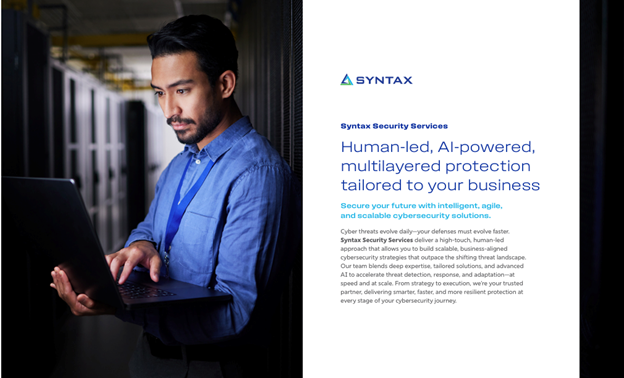For years, threat detection and response has been the heart of security operations, identifying, investigating, and mitigating potential incidents before they become breaches, outages, or costly disruptions. It safeguards daily operations while helping security teams adapt to an ever‑changing threat landscape.
In short, without effective threat detection and response, security operations cannot function effectively.
But the scale, speed, and sophistication of today’s cyber threats demand more than traditional methods can deliver. Attacks are now faster, more complex, and more automated. That’s where generative artificial intelligence (GenAI) is rewriting the playbook, bringing unprecedented speed in identifying anomalies, surfacing hidden indicators of compromise, and accelerating incident response.
By empowering analysts with AI‑driven insights and automation, organizations can move from reactive damage control to proactive, precision defense—meeting modern threats head‑on.
In this blog, we’ll trace how threat detection and response has evolved in recent years, explore where it’s headed in the GenAI era, and outline practical steps security leaders can take to seamlessly integrate GenAI into their security management strategies.
The Evolution of Threat Detection and Response
Prior to GenAI, most organizations relied on one of two main approaches:
- Manual, analyst-driven operations with prescriptive, rules-based‑ alerting
- Traditional AI/machine learning (ML) detection that enabled pattern recognition and anomaly detection but still required heavy human interpretation.
While the step from manual processes to AI/ML was evolutionary, it wasn’t revolutionary.
Security analysts remained buried under alerts, responsible for:
- Monitoring and filtering massive volumes of incoming signals
- Manually investigating anomalies across fragmented tools
- Correlating data across platforms to spot hidden threats
- Making judgment calls on containment and remediation
The sheer complexity and relentless volume of this work made detection and response not only time consuming but also resource draining and, at times, overwhelming. Alert fatigue became the default state, leaving analysts buried in noise and causing critical threats to slip through the cracks.
The consequences are significant: Prophet Security’s State of AI in Security Operations 2025 report revealed that 40% of alerts go uninvestigated, and 60% of teams have suffered breaches tied directly to ignored alerts.
This isn’t a reflection of inadequate expertise. It’s a reflection of inadequate capacity. Even the most skilled teams cannot match the speed, automation, and scale at which today’s adversaries operate without new tools to augment their efforts.
From Security Evolution to Revolution: GenAI Arrives
The arrival of GenAI has not only helped overcome these challenges, it’s also been revolutionary. Where traditional AI could flag suspicious patterns, GenAI adds contextual understanding and scalable automation. It can:
- Automate log correlation and anomaly detection across vast, diverse datasets.
- Enrich alerts with contextual threat intelligence and historical incident data.
- Generate human-readable summaries and prescriptive remediation recommendations to expedite decision making
These capabilities don’t just accelerate threat detection and response; they also elevate overall security operations. Research from Dark Reading found that 91% of cybersecurity professionals believe AI and ML are improving Security Operation Center (SOC) efficiency, underscoring how transformative these technologies have become.
With GenAI, that impact goes even further: enabling SOCs to work smarter, respond faster, and tackle a greater volume of threats—all without the linear staffing increases that traditionally come with scaling operations.
The result is not only operational efficiency but also a stronger, more resilient defense posture.
Redefining the Security Analyst’s Role
Perhaps the most profound change GenAI brings is to the role of the security analyst. Instead of acting as “alert sifters,” bogged down in repetitive triage, analysts become strategic defenders and threat hunters. Their focus shifts to:
- Validating AI-driven findings
- Tuning detection models
- Proactively hunting for emerging risks
- Shaping detection logic to reflect evolving adversary tactics
By reducing noise and repetitive manual work, GenAI frees analysts to concentrate on the high-value activities that build resilience and outpace attackers.
Tangible Security Business Benefits Already Emerging
Security analysts aren’t the only ones experiencing the transformative effects of GenAI. Businesses are too. While adoption is still in its early stages, the organizations already integrating GenAI into their security management operations are seeing clear, measurable results:
- Faster detection and response: Significant reductions in Mean Time to Detect (MTTD) and Mean Time to Resolve (MTTR), shrinking the window of attacker opportunity. In fact, according to IBM’s 2025 Cost of a Data Breach Report, organizations with robust security AI and automation detected and contained data breaches 108 days faster on average than those without AI tools.
- Improved alert accuracy: A dramatic drop in false positives, easing alert fatigue and allowing analysts to focus on real threats.
- Stronger defenses against complex attacks: Enhanced ability to uncover multi-stage or stealthy campaigns that slip past traditional rule-based systems.
- Scalable efficiency: SOCs can now expand capacity and effectiveness without exponential increases in headcount, delivering immediate return on investment.
Organizations using GenAI capabilities are able to reframe security as a business enabler rather than a cost center.
Read more about this topic: From IT Concern to Business Priority: Measuring the Impact and ROI of Modern Security Programs
The Human + AI Partnership in Security Management
To harness the power of GenAI in security operations, it’s important to dispel a common misconception: GenAI is a force-multiplier, not a human replacement. Security is too consequential to leave fully in the hands of machines. The future is human-guided AI, where:
- Machines handle scale, speed, and consistency.
- Humans provide direction, nuance, context, and accountability.
In high-stakes scenarios like deciding whether to isolate a production system or classify a potential insider threat, human judgment remains indispensable.
The goal is not to replace people, but to augment them with superhuman capabilities.
Best Practices for Implementing GenAI in Threat Detection and Response
Unlocking the potential of GenAI in threat detection and response requires more than deploying new technologies and tools. It demands deliberate planning, responsible governance, and measurable outcomes. Security leaders should view GenAI implementation not just as a technology upgrade, but as a transformation of operational strategy. To maximize value and minimize risk, consider these best practices:
- Establish performance baselines: Capture SOC metrics, such as detection accuracy, false positive rates, and response times, before integrating GenAI. This creates a benchmark for measuring improvements and identifying residual gaps.
- Keep humans in the loop: Automation should accelerate workflows, not replace human validation. Always design oversight checkpoints to ensure accuracy and accountability in decisions.
- Prioritize auditability: Every AI-driven action must be transparent and traceable. Ensure your SOC can explain why a recommendation was made, not just what was done.
- Embed ethics and governance from day one: Responsible use of GenAI requires clear guardrails. Integrate ethical considerations, risk management, and compliance requirements into your AI strategy from the very beginning.
- Enablement and upskilling: Ensure analysts are trained to interpret GenAI insights effectively, leverage automation tools confidently, and adapt to evolving AI-enabled workflows. This ensures that GenAI technology adoption translates into measurable performance gains.
By grounding GenAI adoption in these principles, organizations can capture the speed and scale benefits of automation while safeguarding against unintended consequences—achieving both resilience and trust.
Syntax Leads in GenAI‑Driven Security Approach
At Syntax, GenAI is at the forefront of how we run our own security operations, as well as how we secure environments for customers around the globe. By blending advanced GenAI capabilities with deep security expertise, we deliver threat detection and response that is both faster and more precise, without sacrificing the human oversight that security management depends on.
We’ve invested in GenAI‑powered SOC infrastructure, refined our processes to maximize its value, and aligned our governance with industry best practices. The result: a threat detection and response framework that allows organizations to scale security, outpace adversaries, and stay ready for what comes next.
The Road Ahead
GenAI is not just an incremental upgrade to threat detection and response—it’s a paradigm shift. Security teams that embrace it early will move faster, operate smarter, and build stronger resilience against the relentless tide of cyber threats.
The future of cybersecurity will not be human or AI. It will be humans and AI working together to protect the digital foundations of modern business.
If you’re ready to see how Syntax can help you harness GenAI to strengthen your security operations, check out our Security Services overview or connect with our team directly.
Author

Jack Cherkas
Global CISO and VP Security Services, Syntax
Jack is a seasoned cyber professional with extensive leadership experience in cyber security at major global corporations. He has worked across various sectors, including telecommunications, financial services, the UK public sector, and critical national infrastructure. His expertise spans managed services, professional services, consultancy, setting up a CISO organization from scratch, and leading the resolution of major cyber security incidents.


